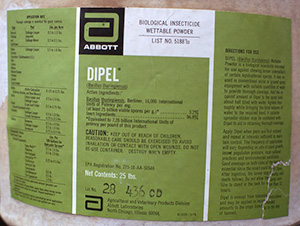Biopesticides: Bt and Spinosad

Gardeners are looking for replacements for conventional pesticides. Some are worried about the effect of a specific chemical on their personal health. Others are switching out of concern for the harmful impacts on the world around them. For these gardeners, biopesticides can be a gentler but effective alternative.
Biopesticides are also called natural or biological pesticides. According to the Environmental Protection Agency (EPA), “Biopesticides are certain types of pesticides derived from such natural materials as animals, plants, bacteria, and certain minerals.” They are generally less toxic to nontarget organisms and the environment.
Bt and Spinosad are two common biopesticides. Specifically, they are microbial insecticides. In general, Bt varieties are pest specific while Spinosad is more broad spectrum. Like all pesticides, we suggest using them as part of an integrated pest management (IPM) program.
The following article answers questions about Bt and Spinosad use in the home garden. It does not cover all there is to know about these pesticides, however. You can learn more about biopesticides by reading the UF/IFAS publication “Natural Products for Managing Landscape and Garden Pests in Florida.”
What are Microbial Insecticides?
Microbe is a shorter name for microorganisms. These are organisms so tiny that we cannot see them with naked eye. The term “microbe” usually means we’re talking about a microorganism that causes a disease. It’s important to remember, too, that there are microbes that keep organisms healthy. Human gut bacteria, for example, are a set of microbes that help us digest our food.
In the case of microbial insecticides, we’re talking about microbes that are harmless to people, but deadly to insect pests. The active ingredient in a microbial insecticide is the microbe itself. It may be bacteria, fungi, protozoa, microbe-carrying nematodes, or even a virus.
Bt and Spinosad, specifically, are bacterial. Bacillus thuringiensis (Bt) is naturally present in the soil, water, and on plant surfaces. Saccharopolyspora spinosa (Spinosad) lives in the soil as well.
How to Microbial Insecticides Work?
Like humans and their garden plants, insect pests are vulnerable to microbes. Microbial insecticides take advantage of this weakness. They contain a high concentration of a microorganism found in nature and known to affect different insect pests. The microbe preys upon the pest. As a result, the pest becomes too sick to continue eating or unable to reproduce.

Bt affects the larval (caterpillar) stage of multiple pest groups. When caterpillars, like hornworms, eat Bt, it begins to ferment in their intestine. The toxins it produces cause the caterpillars stop eating and die a few days later.
Specific varieties of Bt target specific pest groups. Bt var. kurstaki targets caterpillars (butterfly and moth larvae), for example. Bt var. israelensis targets fly larvae, including mosquitoes. Be sure to choose the correct variety of Bt for your insect pest. Read the product label for more information.
Spinosad is a more broad-spectrum microbial insecticide. It affects caterpillars, leaf miners, flies, thrips, beetles, and spider mites. Spinosad works by attacking the nervous system once the pests eat it. Like Bt, the pests stop eating and die a few days after.
Are Microbial Insecticides Safe?
Microbial insecticides do not infect humans, pets, or non-insect wildlife. Rather, each product targets a specific category or life stage of insect pests. Because they are fairly specific, they are less likely to affect other organisms visiting the garden. Farmers have used Bt for over 30 years in the U.S. and around the world. Spinosad is also labeled by the EPA as a “reduced-risk” pesticide.

That said, responsible use is still important. Always read the entire label and follow all directions when applying any pesticide, even a natural one. Check for the correct time of day to apply the product. Determine how much to apply. Reapply only as directed. Also be mindful of the pre-harvest interval (PHI). PHI is the time you must wait after applying to a crop and before harvesting. The PHI for Bt and Spinosad is lower than most conventional pesticides, but still important.
Be careful, too, of the effects of Bt and Spinosad on beneficial insects. The wet spray of Spinosad, for example, is toxic to bees and other beneficial insects. They are minimally affected once Spinosad residue is dry. If you apply the product outside of peak bee-foraging hours, you’ll reduce the risk to bees. Bt, too, requires caution. Butterfly caterpillars are as vulnerable to its toxic effects as pests. Specifically avoid applying them to plants known to host butterflies and other beneficials, like milkweed.
Like all pesticides, using Bt and Spinosad responsibly means identifying pests before you treat. Applying either product to your whole yard could be a poor choice if it is not necessary. You will certainly harm insects that were a part of the healthy ecosystem.
How should I apply Bt and Spinosad?
The usual guidelines for applying pesticides apply to Bt and Spinosad, too. Always read and follow all directions included on the label. Apply them to problem areas, not the whole garden.
For more information on Bt and Spinosad please contact the Pesticide Information Office. For help identifying a pest contact your county Extension office.
Also on Gardening Solutions
- Beneficial Insects
- Biopesticides: Horticultural Oils
- Integrated Pest Management
- Natural Pest and Disease Management
